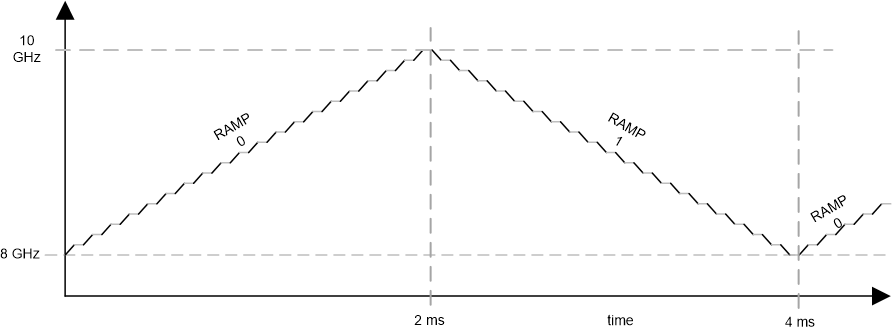ZHCSGL5C March 2017 – April 2019 LMX2594
PRODUCTION DATA.
- 1 特性
- 2 应用
- 3 说明
- 4 修订历史记录
- 5 Pin Configuration and Functions
- 6 Specifications
-
7 Detailed Description
- 7.1 Overview
- 7.2 Functional Block Diagram
- 7.3
Feature Description
- 7.3.1 Reference Oscillator Input
- 7.3.2 Reference Path
- 7.3.3 PLL Phase Detector and Charge Pump
- 7.3.4 N-Divider and Fractional Circuitry
- 7.3.5 MUXout Pin
- 7.3.6 VCO (Voltage-Controlled Oscillator)
- 7.3.7 Channel Divider
- 7.3.8 Output Buffer
- 7.3.9 Power-Down Modes
- 7.3.10 Phase Synchronization
- 7.3.11 Phase Adjust
- 7.3.12 Fine Adjustments for Phase Adjust and Phase SYNC
- 7.3.13 Ramping Function
- 7.3.14 SYSREF
- 7.3.15 SysRefReq Pin
- 7.4 Device Functional Modes
- 7.5 Programming
- 7.6
Register Maps
- 7.6.1 General Registers R0, R1, & R7
- 7.6.2 Input Path Registers
- 7.6.3 Charge Pump Registers (R13, R14)
- 7.6.4 VCO Calibration Registers
- 7.6.5 N Divider, MASH, and Output Registers
- 7.6.6 SYNC and SysRefReq Input Pin Register
- 7.6.7 Lock Detect Registers
- 7.6.8 MASH_RESET
- 7.6.9 SysREF Registers
- 7.6.10 CHANNEL Divider Registers
- 7.6.11 Ramping and Calibration Fields
- 7.6.12 Ramping Registers
- 7.6.13 Readback Registers
- 8 Application and Implementation
- 9 Power Supply Recommendations
- 10Layout
- 11器件和文档支持
- 12机械、封装和可订购信息
7.3.13.2.1 Automatic Ramping Example (Triangle Wave)
Suppose user wants to generate a sawtooth ramp that goes from 8 to 10 GHz in 2 ms (including calibration breaks) with a phase-detector frequency of 50 MHz. Divide this into segments of 50 MHz where the VCO ramps for 25 µs, then calibrates for 25 µs, for a total of 50 µs. There would therefore be 40 such segments which span over a 2-GHz range and would take 2 ms, including calibration time.
Table 17. Sawtooth Ramping Example
NOTE
To calculate ramp_scale_count and ramp_dly_cnt, remember that the desired calibration time is 25 µs.
